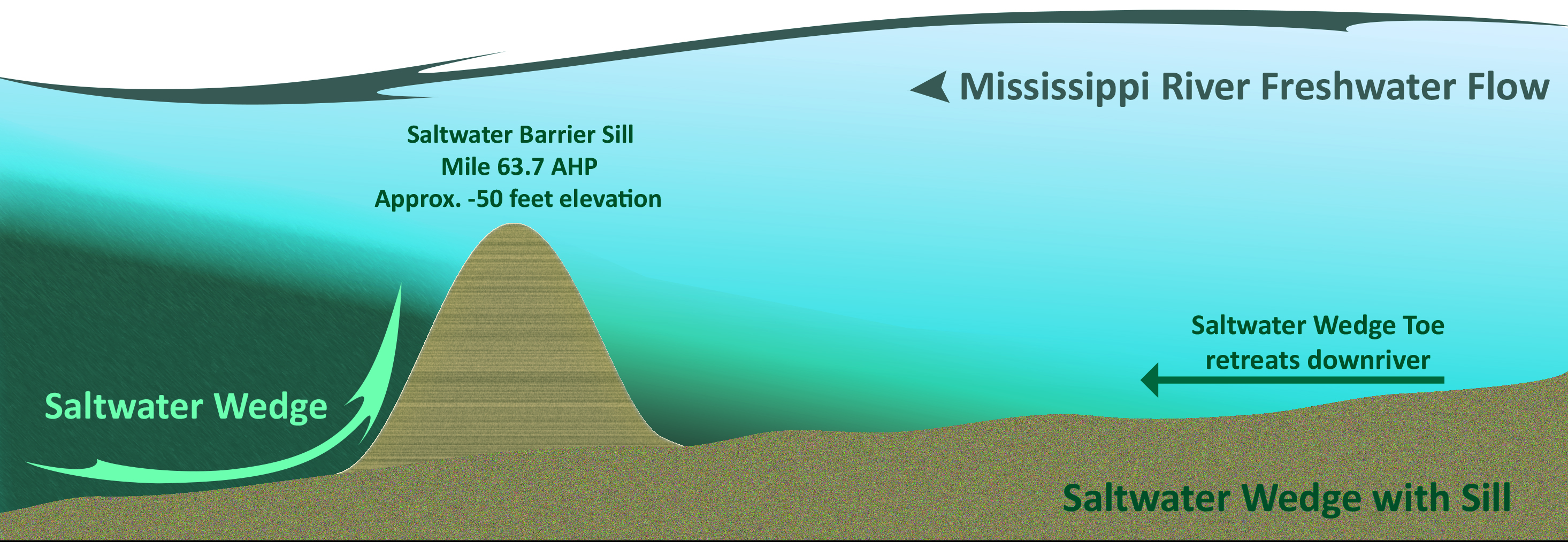BACKGROUND
The Congressionally authorized enlargement of the Mississippi River’s deep-draft channel from 45 ft. to 50 ft. causes an increase in the duration and extent of annual saltwater intrusion. Since the Mississippi River is a source for municipal and industrial water supply, the effects of increasing the navigation channel depth from 45 ft. to 50 ft. were carefully analyzed in the studies for the deeper channel. The characteristics of saltwater intrusion, the impacts of the increase in saltwater intrusion, and measures for mitigation of these impacts follow.
SALTWATER BEHAVIOR
The thalweg, or bottom profile, of the Mississippi River is deeper than the Gulf of Mexico water surface level up to River Mile 350 Above Head of Passes (AHP). This location is about 15 miles downstream of Natchez, Mississippi. Salt water in the Gulf of Mexico is denser than the fresh water flowing in the Mississippi. Therefore, at low river flows, the Gulf’s salt water moves upstream along the bottom of the River underneath less dense river fresh water.
A number of factors impact the upstream movement of salt water from the Gulf. The dominant factor is the volume of flow in the River. However, flow duration, channel slope, wind velocity and direction, tides, and water temperature all influence the movement of the salt water.
SALTWATER WEDGE
Because salt water has a greater density than fresh water, it moves upstream in the form of a wedge. A highly stratified wedge is common to deep rivers with high freshwater flows such as the Mississippi. The leading edge, or "toe", of the saltwater wedge is well defined. However, some mixing occurs along the freshwater-saltwater interface and mixed flows eventually reach the surface. When the rate of erosion of the saltwater along its leading edge is equal to the saltwater flow upstream along the channel bottom, the location of the wedge is stable, or "arrested".
When freshwater flows increase or decrease the saltwater wedge retreats downstream or advances upstream, respectively. However, the movement of the wedge is less responsive to increases in flows than to decreases. Historical data indicate that the quality of surface waters will exceed the U.S. Environmental Protection Agency public water supply standard of 250 ppm chloride approximately 15 to 25 miles downstream of the toe of the wedge.
SALTWATER BARRIER SILL
A sand sill constructed to the proper height above the river bottom can reduce saltwater flow and artificially arrest the wedge. In order to mitigate for the increased duration and extent of saltwater intrusion above Mile 64 AHP, an underwater sill will be constructed when necessary.
Location of the Saltwater Sill
Conservative estimates show that the sill would need to be constructed an average of about once every five years. Since completion of the 45-ft. channel, a sill has been constructed three times: in 1988, in 1999, and in 2012. Construction is currently underway for the 50-ft. channel.

Construction of the Saltwater Sill
in the Mississippi River
The POC for this page:
Lower Mississippi River & Tributaries Branch
CEMVN-ED-R
New Orleans,LA 70160
CEMVN-Water-Management@usace.army.mil